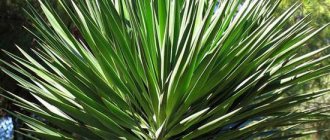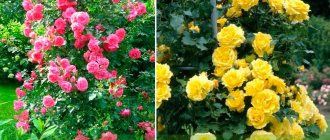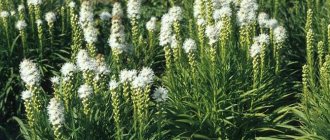Miscanthus, a new variety that will replace cotton.
Russian genetic breeders managed to develop a variety of miscanthus adapted to Russian climatic conditions, as a result the plant acquired a significant supply of useful qualities: increased content of a valuable component of production - cellulose, high volume of useful biomass (45% - more than in cotton or wood), low cost for processing, resistance to winter temperatures. One sowing of miscanthus provides a harvest for the next thirty years.
Miscanthus:
Miscanthus (lat. Miscanthus) is a genus of perennial herbaceous plants of the grass family (lat. Poaceae).
About 40 species of the Miscanthus genus are known. Species of the genus Miscanthus are distributed in tropical, subtropical and warm-temperate zones of Asia, Africa and Australia.
Species of the genus Miscanthus are perennials, 80-200 cm high. There are species up to 300 cm high. (Giant Miscanthus - lat. Miscanthus Giganteus, Chinese Miscanthus - lat. Miscanthus sinensis). Plants of the Miscanthus genus are usually large, rather loose turfs (close clusters of leaves and stems) with creeping rhizomes. Stems are erect. The leaves are leathery and scale-like. Leaf blades are 0.5-1.8 cm wide, linear or lanceolate-linear, very rigid. Panicles are more or less fan-shaped (with long lateral branches and a very shortened common awn), 10-30 cm long. Spikelets 0.3-0.7 cm long, with one fully developed flower, surrounded by long silky hairs extending from their base and from the back of the glumes. The glumes are equal to the spikelets, thin-skinned. The lower lemmas are shorter, membranous, without or with awns.
Unpretentious. They grow on various types of soil, both dry and wet, except sand and heavy clay. They grow in clumps. They prefer warm, humid climates. Feels good both in sunny areas and in partial shade. They love moist soil. Tolerates short-term drought.
Some species have adapted well to the conditions of central Russia. But in Russian conditions in winter it is necessary to shelter from the cold.
They reproduce by sowing seeds in winter and carefully dividing the bush in the spring. They bloom in summer from June to July, some species in August and September.
Miscanthus is usually used as an ornamental plant in landscape design. It is planted along the banks of reservoirs and in gardens. In autumn, its foliage turns various shades of yellow, brown, and burgundy. It is also used to create floral compositions.
New miscanthus variety:
Until now, miscanthus has not been cultivated and was found exclusively as a wild species. Russian genetic breeders managed to change it in such a way and adapt it to Russian climatic conditions that the plant acquired a significant supply of useful qualities.
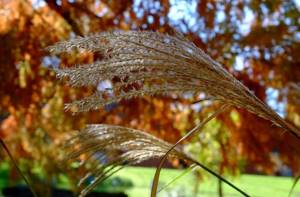
The new miscanthus variety developed is unique in its properties:
– it has an increased content of a valuable component of production – cellulose,
– high volume of useful biomass (45% – more than in cotton or wood),
– low processing costs,
– resistant to winter temperatures.
One sowing of miscanthus provides a harvest for the next thirty years.
Application of the new miscanthus variety:
This plant (miscanthus) is a source of high-quality cellulose, a substance that is part of the cells of all higher plants. Miscanthus is roughly comparable to cotton in cellulose content, but is much cheaper to grow. The new variety of miscanthus is able to completely replace cotton (the latter is bought abroad, in the countries of Central Asia). The system for extracting cellulose from miscanthus has also been developed.
After microbiological processing, the new miscanthus variety can be used anywhere: in the production of paper, viscose, plastics, biofuels, lactic acid and even gunpowder.
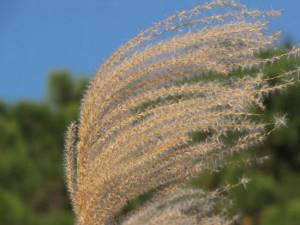
Note: Photo https://www.pexels.com, https://pixabay.com
Site Map
miscanthus gracilimus zebrinus zebrinus zebrina planting and care giant description Chinese varieties photo sugar-flowered cultivation cereal grass flower miscanthus species strictus seeds winter winter hardiness in open ground gold bar sinensis Chinese little zebra planting and care reviews buy flamingo adagio miscanthus purpurescens in landscape design Ukraine Moscow region 4802
Demand factor 266
comments powered by HyperComments
Miscanthus
Kolkvitsia planting and care photo Propagation of Kolkvitsia by cuttings Photos of varieties Kolkvitsia planting and care in open ground Propagation by cuttings Photos of varieties
Chinese Miscanthus 'Silberfeder'
Miscanthus (Miscanthus) is one of the most common ornamental grasses with tall, hard leaves and drooping silvery, golden or pinkish feathery panicles - inflorescences. Blooms in summer and autumn, depending on the variety. Reaches more than 2 m in height.
Miscanthus. Growing conditions.
Sunny location, moist well-drained soil. Some types of miscanthus are aggressive and require restriction of root growth. The depth of the limiter can be small (10-15 cm), since the root system of miscanthus is superficial, but in height the edge of the limiter must be raised above the ground by 5 cm. Powerful, strong roots have the ability to “step over” it.
Miscanthus. Application.
- looks great in containers;
- can be used as a plant screen;
- looks good both as a soloist and in a group planting;
- Miscanthus decorate the banks of reservoirs;
- used in bouquets as dried flowers.
There is a wide variety of varieties and forms adapted to different growing conditions and uses in garden design.
A powerful perennial grass with erect, leafy stems in the lower part up to 300 cm, in our conditions up to 2 m in height. The leaves are linear, hard, rough with a thick ridge in the middle, about 1.5 cm wide. The inflorescence is a loose panicle with single-flowered spikelets up to 0.7 cm long. Winter hardiness is relative. For the winter, be sure to mulch the plantings.
Here are some varieties that can be cultivated in central Russia:
'Blondo' - height up to 2 m, good cold resistance (Zone 4);
Miscanthus chinensis “Blondo”
'Gracillimus' - height 2 m, inflorescences copper color, leaves narrow with a cream longitudinal stripe, golden yellow in autumn. The plant shape is round (Zone 5);
Miscanthus chinensis "Ggracillimus"
'Zebrinus' - height 2.4 m, leaves with transverse cream stripes (Zone 5).
Miscanthus chinensis "Zebrinus"
Among the main advantages of cereals is the ability to increase mass. Miscanthus is a warm-growing ornamental grass, it begins to grow in late spring, but then with the onset of the warm season it confidently begins to grow. It begins to bloom in July with white or pinkish-silver paniculate inflorescences. Preventative mulching in case of a winter with little snow is desirable.

Sugar-flowered miscanthus "Robustus"

Miscanthus sugarflower "Gotemba Gold"
Miscanthus purpurascens
The orange and purple colors of Miscanthus blush will be topped with white feathers late in the season. Effective when used with other miscanthus to add color contrast and varying heights.
Miscanthus purpurascens
Be sure to find a place in your garden for ornamental grasses.
General description with photo
Miscanthus or fan grass is a representative of perennial ornamental grasses native to the subtropical regions of the eastern hemisphere. It is most widespread in the African savannas. It is cultivated for technical and decorative purposes and serves as decoration for gardens and park areas. Due to its high winter hardiness, planting and caring for miscanthus is possible in open ground conditions throughout central Russia and the CIS countries.
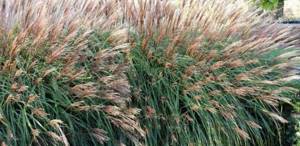
It is a herbaceous plant with long, hard and dense leaves and paniculate inflorescences. The leaf blades are linear in shape, pointed, with a very rigid vein, due to which they retain their straight shape almost without lodging. Their length, depending on the variety, can vary from 0.5 to 1.5 m. Thin peduncles are carried above the general leaf crown, on each of them only one spike-shaped panicle with thin, silky-looking hairs is formed. Seeds of different varieties may or may not have awns and leathery scales. The root system of the plant is highly branched, prone to growing in breadth.
Unsurpassed Miscanthus
Ageratum flowers types, varieties of ageratum 15 photos with names planting, growing and care
A sophisticated decoration for the autumn garden are different forms of miscanthus. This is one of the most popular cereals in ornamental gardening. No grass can compete with it in beauty, variety of varieties and forms, adaptation to environmental conditions and methods of use in garden design.
Two species are most often used in gardens: sugar-flowered miscanthus (M. sacchariflorus) and Chinese miscanthus (M. sinensis), which has the largest number of forms and varieties.
Miscanthus sugarflower forms tall thickets of stiff stems up to two meters high. The distribution range of the species is wet meadows, sandy river banks, forest glades, open rocky slopes of Japan, Manchuria, Korea, and the Ussuri River valley in Russia.
Our advice:
The plant forms powerful clumps and long rhizomes, therefore it is considered a rather aggressive species and requires a limit around the perimeter of the planting site to 30 cm deep and up to 5 cm above the soil surface.
Sugar-flowered miscanthus looks impressive on the shore of a pond. It is used to populate large areas. At the end of summer - beginning of autumn, it blooms with fluffy panicles 12 - 30 cm long. In autumn, the leaves and stems turn yellow and retain their decorative effect in winter, raising silver-white inflorescences above the snow.
Miscanthus chinensis has been cultivated since 1875. In nature, the species is found on open, more or less dry grassy slopes, among shrubs, and in forest glades in the Primorsky Territory, Eastern China, Korea, and Japan. ABOUT
n good as a curtain, hedge, container plant or accent plant. Panicles of Chinese miscanthus are used in dry winter bouquets and for making floral arrangements. The flower stalks of the plant reach a height of two meters. Its leaves are wider than those of Miscanthus sugarflower. It blooms in September with large panicles, which by the end of autumn turn slightly yellow and become fluffy. The 30 cm long inflorescences remain decorative both in a snow-covered garden and in dry bouquets. Miscanthus chinensis has shortened rhizomes, so it forms very beautiful loose “bushes”.
There are already more than a hundred varieties of Chinese miscanthus. However, not all varieties that are imported into our country manage to bloom before the onset of winter. In landscaping they are used exclusively as decorative foliage plants.
Popular varieties of Chinese miscanthus
- Kleine Fontane and Kleine Silberspinne are the earliest varieties; they throw out panicles already in mid-August, the height of the peduncles is 80 and 110 cm, respectively.
- Miscanthus chinensis Graziella has narrow green leaves. At the end of August - beginning of September, white fluffy inflorescences bloom on peduncles up to 180 cm high.
- The Strictus variety is characterized by variegated yellow-green leaves that extend from the stem in one plane. That is why the plant is also called “porcupine grass.” Under our conditions, it ends the growing season in the phase of emerging into a tube or the beginning of throwing out a panicle.
- Miscanthus Variegatus has white-striped, showy leaves; in our conditions it does not have time to bloom, so it enters winter in the phase of throwing the panicle into the tube.
- The Zebrinus variety has green leaves with uneven yellow horizontal stripes, peduncles up to 2 m high. It blooms in late September with red panicles.
Growing conditions and characteristics of miscanthus
The soil. All miscanthus love fertile soil.
Watering. Regular watering will provide the plants with a powerful and chic appearance, as well as a good wintering.
Place. The culture requires a sunny place protected from the wind.
Temperature. Like all heat-loving cereals, miscanthuses begin their growing season in early to mid-May. In warm summers they grow quickly and powerfully.
Feeding. They respond well to spring feeding with organic and mineral fertilizers.
In autumn, the leaves and panicles of miscanthus are not cut off; they not only decorate the winter garden, but also serve as additional shelter for the plants.
Use in garden design
In flower beds, miscanthus partners can be goldenrods, New Belgian and New England asters, delphiniums, buzulniki, phlox, and daylilies. Miscanthus inflorescences look incredibly beautiful in large floral arrangements and dry bouquets, especially when placed in floor vases.
Miscanthus planting and care
In the Yaroslavl region they plan to grow miscanthus for the production of disposable tableware
The size of the sown area at the initial stage is determined at 2 thousand hectares. Further it is planned to increase the area for planting to 30 thousand
The production of packaging and disposable tableware from miscanthus will become a trend in the Russian cardboard market for the next ten years, experts say. The development of a new industry will reduce deforestation and reduce plastic production.
Miscanthus is a perennial herbaceous plant that can be grown in one field for 15 to 30 years, undemanding to soil quality, and adapts well to unfavorable conditions.
They plan to grow miscanthus in the Yaroslavl region.
“Our enterprise consists of two: LLC Production Association “Romanovsky Printer” and LLC Bio-engineering,” the head of one of the companies, Roman Fomichev, told Deputy Chairman of the Government of the Yaroslavl Region Valery Kholodov today. “And together we decided to set up production for the production of disposable biodegradable tableware and cardboard packaging for various areas of trade. Today in Russia, in our opinion, there is still no company that would produce this kind of high-quality product.
Roman Fomichev noted that when thinking about raw materials for disposable tableware, the idea came to miscanthus - an alternative to wood. This plant is already successfully grown in Siberia, the Penza region and Kaliningrad. In the Yaroslavl region, the territory where miscanthus will be planted has not yet been determined.
Deputy Chairman of the Regional Government Valery Kholodov supported the project, the implementation of which will create new jobs.
In addition, goods produced from miscanthus can be sold to agricultural enterprises, for example, egg packaging to poultry farms. Also, the merged companies can declare themselves as agricultural producers, thereby receiving the support of the regional department of the agro-industrial complex and the consumer market.
“We will conclude a memorandum of intent with the Department of Agro-Industrial Complex, and then a cooperation agreement at the level of the Regional Government for the implementation of this project, attractive from the point of view of agricultural development,” emphasized Valery Kholodov. “In addition, thanks to the cultivation of miscanthus, deforestation will be reduced and the consumption of plastic will be reduced - bags, packaging trays, disposable tableware, which causes enormous harm to the environment.
Let us recall that the Yaroslavl region became interested in the project for growing miscanthus two years ago, when at the Interregional Agrarian Exhibition and Forum “Yaroslavl Field Day”, the famous agricultural economist, now the director of the Federal State Budgetary Institution “VNII Ecology” Ivan Starikov spoke about the promising direction for the production of packaging and disposable Miscanthus dishes. It was noted that the Yaroslavl region has good prospects for growing and processing this plant.
(Source and photo: official website of the Ministry of Agriculture of the Russian Federation).
Botanical description
Varieties and types of phlox description, photo
The creeping rhizome is capable of penetrating deep into the soil up to 6 m. The shrubs are spreading. The erect stems range in height from 80 cm to 2 m. The leaf blades are leathery, scaly, long, only 0.5-1.8 cm wide. The lush green color in the fall gives way to yellow, brown, bronze, and burgundy shades. The fan-shaped panicles are 10-30 cm long. At the beginning of flowering they have a pinkish tint, then become silvery. The flowering period occurs in mid-July-early August, if the summer is cool - even later.
The plant is hardy and easy to care for. Even a novice gardener can cope with this; in return, the grass will be a wonderful addition to your garden.
Benefits and harms
In addition to decorative properties, miscanthus has practical significance. It is used as fuel for power plants. The moisture concentration in the raw material is low, therefore, during combustion, a large amount of energy is released, while little ash is formed.
It should be remembered that miscanthus is an aggressive plant that displaces other garden crops and quickly grows in width. To limit the growth of the grass, root growth limiters must be dug in around the perimeter: up to 30 cm in depth, it is advisable to create an obstacle to a height of 5-10 cm above the ground surface.
Miscanthus after flowering

There are types of miscanthus that are frost-resistant, while others simply need good shelter for the winter. If you have planted a fairly delicate variety of such an ornamental grass, then you will have to provide it with protection both from frost and from sudden changes in temperature. In the case when it gradually gets colder outside, the grass may have time to adapt, but if the frost is unexpected, then the bushes die in most cases. In order to protect such ornamental plants, it is necessary to cover the bushes with a film, placing it in a hut, while air must flow from the side parts under the cover. Then, on top of the film, you need to install 2 wooden shields, also like a hut. However, before covering the miscanthus, it is necessary to cover the area where it grows with a very thick layer of mulch, which can be any loose soil.
Miscanthus - Gigantus
Once planted, it grows for at least 20 years! Miscanthus - Gigantus
(otherwise known as Chinese miscanthus, Chinese reed or elephant grass)
| Miscanthus is a very economical and environmentally friendly crop: after planting and sprouting, it does not require additional care even for the soil. There are no annual costs for seeding material, as well as for tillage. All that remains to be done is to collect the annual harvest! Miscanthus is a C4 plant, therefore this reed is very powerful and hardy. This means that after planting the plant once, its creeping rhizome will produce new shoots every year. According to current estimates, the plant's yield lasts for 20-25 years. |
Miscanthus does not form seeds when growing in Central Europe. Therefore, propagation of the plant must be done vegetatively. For this purpose, rhizomes are used, which must be planted using a semi-automatic planting machine (10,000 seedlings per 1 hectare). It is recommended to plant in April.

This crop does not require any fertilizer. Miscanthus grows well in any soil suitable for growing corn. For favorable growth of miscanthus, it is necessary to get rid of weeds in the first two years after planting. Due to the fact that miscanthus, like corn, belongs to the cereal family; Weed killers used for corn are also suitable for miscanthus. Two years after planting, the leaves that fall in winter completely cover the soil, which prevents the growth of weeds. Thus, no weed control is required in all subsequent years. After the leaves and shoots fall off in winter, the plant dries to a moisture content of 15-20%. Depending on the planting location and climate, annual harvesting is expected within two years of planting - ideally, harvesting should be done in the spring. According to its purpose, the harvest is carried out using a conventional corn straw cutter or through a cutting mechanism and a baling press. Miscanthus as a covering material (decorative material) Many well-known enterprises are intensively engaged in the development of technologies for producing fuel and plastic from miscanthus.
Harvesting with Traditional Corn Straw Cutter Application:
According to long-term field tests, one hectare of source material on average produces about 15 tons of absolutely dry harvest - which in terms of calorific value corresponds, for example, to the sale of approximately 8,000 liters of extra-light liquid fuel. 2.23 kg of finely chopped miscanthus with a moisture content of 14% corresponds to heating value of one liter of extra-light liquid fuel. Source;
https://www.miscanthus-rhizome.at Without any problems, Miscanthus can be pressed into briquetted pulp WITHOUT the admixture of any binder.
Miscanthus care
Selecting a location
The place for planting the crop should be well lit; even a small shadow can prevent it from fully blooming. It is desirable that the site is located in a lowland and the roots are fed with moisture. The coastline near bodies of water is best suited. The plant should not be exposed to strong winds or drafts.
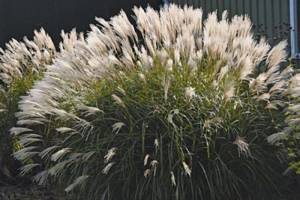
Blooming miscanthus
The soil
The soil must meet certain requirements. It is desirable that it be slightly acidic or neutral. The soil is suitable loamy, sandy loam, peat or turf. Before planting the plant, the soil should be dug up, freed from weeds, and organic matter should be added to it.
Watering
Miscanthus loves moisture very much, so watering should be regular and plentiful. Prolonged drought has a bad effect on the plant; therefore, watering should be done more often in the summer. You should also not be overzealous, since stagnation of moisture also negatively affects the plant.
Top dressing
Fertilizing should be applied sparingly in the second year after planting. The first time fertilizer is applied based on nitrogen; even ordinary urea will do. At the beginning of June, nutrients are added, for example, humates. By the end of summer, the soil is fertilized with a potassium-phosphorus additive.
Fencing
Crop varieties prone to overgrowth should be limited around the perimeter. The fact is that the roots of miscanthus do not go too deep underground, so their growth can be stopped with the help of metal sheets dug to 27 cm.

Fencing option for miscanthus
Weeding
After each watering, the soil should be loosened and weeds should be removed. It is also important to weed the crop during the period of active growth so that weeds do not slow down its development.
Preparing for winter
To avoid the death of roots in winter, it is necessary to cover them with mulch. You will have to make a hut around heat-loving varieties and cover them with film or similar material. It must allow air to pass through well, so it cannot be too dense.
Plant propagation
Miscanthus is propagated by dividing the bush, which is the most favorable way. The plant itself prefers to grow in one place, but after some time, it begins to rot on its own, and it needs to be replanted, miscanthus propagated by dividing the bush, which is done in the spring or early summer. The separation procedure must be very careful, because if the plant is damaged it will take a long time to recover.
Another method of propagation is seeds. Through this method of propagation, you get a plant that is not quite ready, compared to what grows from a piece of the main bush when it is divided. When planted with seeds, miscanthus does not acquire its decorative properties very quickly; after three or even four years it takes the form of a normal and regular plant. Seeds need to be germinated in pots with peat before spring. As soon as the snow melts and the soil has completely thawed, they need to be planted in the ground. If you plant miscanthus using seeds, then the decorative properties are not preserved, as a result of which almost everyone chooses the vegetative method of plant propagation.
All known pests and diseases cannot harm the plant; miscanthus grows healthy and is not attacked by any diseases or parasites. This aspect only adds positive characteristics to an already beautiful ornamental plant.

Caring for miscanthus in the garden
Proper planting and subsequent care are important for plant growth and health. Plantings must be regularly watered, fed, weeded, pests destroyed, and diseased bushes removed.
How to water decorative miscanthus
This grass loves moist soil. The root system of this plant dries out quickly without water. The bush will stop growing and die.
The soil is thoroughly watered without fear of rot due to excess moisture. Watering is done from a watering can or from a hose. In dry weather, you need to regularly monitor the degree of soil moisture.
What and how to feed plants
In the first year, the seedling is not fed; it only needs nutrients from the garden soil placed at the bottom of the hole.
Next summer, three feedings are made:
- In mid-May, the soil under the plants is watered with a urea solution or other nitrogen fertilizer.
- In June, the soil is watered with water containing humates.
- In the second half of summer, phosphorus and potassium mineral fertilizers are applied.
All mineral and organic fertilizers are diluted in water strictly in accordance with the manufacturer’s instructions. Excessive nitrogen content in the soil leads to lodging of miscanthus foliage. Excess of other fertilizers also has an adverse effect on growth and flowering.
Loosening and mulching
Mulching the soil around a young, weak seedling must be done in hot and dry weather to avoid drying out of the roots. There is no need to loosen the soil around the stems. This grass has a root system that spreads to the sides, and loosening of the soil occurs naturally.
Miscanthus, in favorable conditions, tends to spread unlimitedly throughout the area, giving new shoots from horizontal roots. Therefore, the growth area is limited by digging borders made of boards and slate into the ground, and leaving no gaps. The barriers are buried 20 cm into the ground. They rise 10-15 cm above the surface. This is done in the first season, immediately after planting the sprouts.
Growing miscanthus - useful care tips
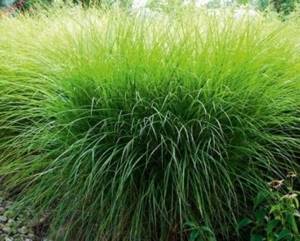
Gracillivus
Adult miscanthus tolerates Russian winters well, but when planted in autumn, even quite cold-resistant varieties may not withstand light frosts. The fact is that only well-rooted plants can withstand low winter temperatures. When planted in the fall, young plants do not have time to fully restore the root system, which is the reason for their death.
That is why it is best to divide and replant miscanthuses in the spring. Although miscanthus is considered a winter-hardy plant, to be on the safe side, it makes sense to sprinkle the soil around it in the fall with humus or peat in a layer of 8-10 cm, and in winter to rake snow up to the bush.
If the bush has already gained strength, then it can survive the drought, but you will have to forget about its decorative qualities for a while, but young plants may die.
You can grow miscanthus in one place for a very long time - 10 years is not a long time for it. However, with age, the middle of the bush will begin to die off. To preserve the decorative appearance of the plant, in the spring the rhizomes are dug up, divided into parts and planted in a new place.
In autumn, miscanthuses are not pruned in order to be able to admire their beauty in winter. But by spring the bush loses its decorative appearance; it is cut off so that young leaves replace those that withered over the winter.
Fertile soil with a neutral reaction is ideal for growing miscanthus. If this condition is met, miscanthus does not need additional feeding. Moreover, if you overfeed miscanthus, they reduce their decorative value due to the fact that the accelerated growth of shoots ends with their lodging.
Miscanthus is propagated by cuttings of rhizomes. In the first year, the young plant grows very slowly, but this is not a cause for concern; in the second half of summer the bush will appear in all its glory.
To propagate miscanthus, it is better to divide young bushes. The old bush has a very powerful root system and digging it out is a real challenge.
Miscanthus
Miscanthus, also called fantail, is closely related to sugar cane and is directly related to the genus of herbaceous perennial plants of the Poa family (cereals).
Under natural conditions, such a plant can be found in tropical and subtropical regions of Australia, Asia and Africa. This genus includes approximately 40 species. This ornamental grass is very popular among gardeners.
In landscape design, miscanthus is used to decorate lawns and decorative ponds, and this grass is also indispensable when creating dry floral compositions.
Features of Miscanthus
Miscanthus is a perennial plant and can reach a height of 0.8 to 2 meters. Its creeping rhizomes in some cases reach a depth of six meters. Stems are erect. The width of the leathery scale-like leaf plates is from 0.5 to 1.8 centimeters. The fan-shaped panicles, 10–30 centimeters long, include spikelets.
This plant is distinguished by its unpretentiousness, endurance and environmental safety. This ornamental grass is also used as fuel for power plants, since when it is burned, a large amount of energy is released, and very little ash is formed, because the raw material contains a small amount of moisture.
What time to plant
Miscanthus must be planted in the spring after the soil has warmed up well (from the last days of March to the second half of May).
This cereal is heat-loving; therefore, to plant it, you need to choose sunny, well-warmed areas that are protected from the cold wind.
Such plants need a sufficient amount of water, so moist nutrient soil located in the coastal zone is best suited for them. Miscanthus does not have any special requirements for the soil, but it grows and develops very poorly on heavy clay and sand.
How to plant
To plant, you will need to purchase adult seedlings from a specialized store. The fact is that this cereal has a fairly long period of active growth.
It should be taken into account that such a plant begins to grow only after the air warms up to 25 degrees. In this regard, if you plant a young seedling, then it simply will not have enough time before the onset of frost to take root well and prepare for wintering.
The hole is filled with soil, constantly compacting it so that there are no voids left. The planted plant must be watered very well.
Giant Miscanthus (Miscanthus giganteus)
This species has long been cultivated by gardeners, and experts believe that it is a complex hybrid, but no one knows how it originated. Erect shoots can reach a height of up to 300 centimeters. Weeping leaf blades are about 0.25 m wide.
They are painted dark green, with a white stripe running along the central vein. From the shoot, the leaves spread out in different directions, which in appearance is very similar to a large fountain.
Flowering is observed at the end of the summer period, with light pink panicles appearing, acquiring a silvery color over time. If the summer period in the region is cold, then miscanthus may not bloom at all. Often this species is planted as an accent in the background.
It should be taken into account that at the end of the summer, its lower leaves fade; therefore, the lower part of the miscanthus will need to be masked.
Miscanthus species
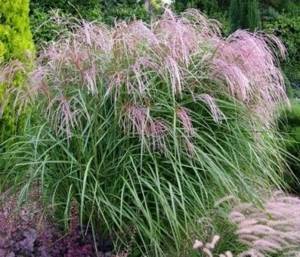
However, there is one fundamental difference between these two species - sugar-flowered miscanthus is a very aggressive plant, actively spreading in different directions. In this case, a loose thicket is formed, somewhat reminiscent of wheatgrass, but only many times larger.
The plant produces long rhizomes that quickly spread in different directions; it is extremely difficult to get rid of them. The problem is that the roots are so sharp that they can hurt your hands. In addition, if only a small piece of rhizome remains in the soil, the plant again begins to reclaim its territory.
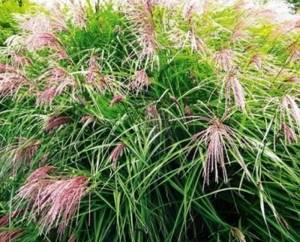
Kleine Fontane
But growing Chinese miscanthus is for us. It grows very slowly, is not at all aggressive and does not become a weed in the area. This species forms a dense bush 2.0-2.5 m high, consisting of many stems with narrow leaves, their main feature being drooping edges. So even before flowering it is very picturesque. Moreover, it is good both in a single planting and growing in the background of a flower garden, being an excellent background for bright flowers.
In autumn, miscanthus becomes a flower garden favorite. After all, by this time large, spreading panicles appear. At first they have a pink tint. And later they become silvery-white and meet the winter in this form.
Features of planting miscanthus
The best time to plant decorative miscanthus is spring, mid-May. The plant has a long growing season and begins to actively grow at plus 25°C. If the sprout is planted late, it will not have time to form an adult bush and bloom.
Where is the best place to plant miscanthus on the site? This ornamental grass loves sunny places, which should be taken into account when planting sprouts in multi-level flower beds, near the walls of houses and near ponds. In shaded areas, bushes grow slowly and may not bloom.
The proximity of plants is not as important as the composition of the soil. Lush bushes with flowering panicles grow on moderately fertile soils
How to plant miscanthus seedlings? The distance between the holes corresponds to the size of an adult plant; it is different for different varieties, so when planting, they are guided by the recommendations of the seedling manufacturer:
- After digging up the soil, holes are made in the ground, the volume of which is larger than the root system of the sprout.
- Fertile garden soil is placed at the bottom of the hole.
- A seedling is placed in a hole and covered with earth, without deepening the above-ground part.
- Lightly compact the earth with your hands.
- The seedling is watered abundantly.
Caring for miscanthus in the garden

How to care for miscanthus outdoors
Watering
Young plants require strength to take root - they should be watered abundantly and often. In the future, watering should also be regular.
Pay special attention during dry periods. At this time, water with a hose to not only shed the soil generously, but also spray the greens
Loosening the soil
After watering, loosen the soil. Remove weeds - they not only spoil the appearance, but can choke out young growth; in the future, the crop can cope on its own. To make the task easier, mulch the tree trunk circle with a layer of peat about 3 cm thick.
Top dressing
In the first year after planting, the plant does not need fertilizing; start fertilizing in the second year of growth. Feeding should be regular, but moderate. For example, excess nitrogen will provoke lodging of bushes.
Three feedings per season are enough:
- Apply the first one in mid-May (use a urea solution);
- At the beginning of summer, water with humates;
- After about 1.5 months, add potassium-phosphorus granules to the soil.
Tall varieties need staking.
Reproduction methods
Most often, the plant is purchased as ready-made seedlings from nurseries, but if it is already available on the site, you can get new bushes by dividing the root system. Specimens that have reached 3-4 years of age are suitable for this. It is at this age that part of the turf begins to die off, which spoils the appearance of the flowerbed, so planting becomes not only a desirable, but sometimes a necessary process.
First, the dug out bush is carefully separated with a sharp shovel in the upper part, and then carefully torn to the end with your hands in order to minimally injure the root system. Veernik does not like transplants; usually after this he is sick for some time and sometimes takes a long time to recover.
As for seed propagation, the method of planting miscanthus with personally collected seeds is considered ineffective. Firstly, due to the loss of decorative qualities, and secondly, due to the short summer and not hot enough for the seeds to ripen.
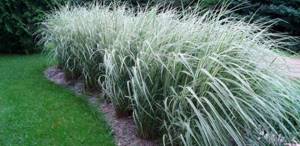
If you still managed to collect the seed material, it can be sown using seedlings or direct planting in open ground. Sometimes you can find giant miscanthus seeds on sale. The agricultural technology for planting them remains the same.
When growing seedlings, transplanting into open ground is carried out by transshipment without breaking up the soil clod.
Types and varieties of miscanthus with photos and names
Giant Miscanthus (Miscanthus giganteus)
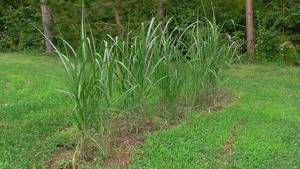
This species has long been cultivated by gardeners, and experts believe that it is a complex hybrid, but no one knows how it originated. Erect shoots can reach a height of up to 300 centimeters. The weeping leaf blades are about 0.25 m wide. They are painted dark green, with a white stripe running along the central vein. From the shoot, the leaves spread out in different directions, which in appearance is very similar to a large fountain. Flowering is observed at the end of the summer period, with light pink panicles appearing, acquiring a silvery color over time. If the summer period in the region is cold, then miscanthus may not bloom at all. Often this species is planted as an accent in the background. It should be taken into account that at the end of the summer, its lower leaves fade; therefore, the lower part of the miscanthus will need to be masked.
Chinese Miscanthus (Miscanthus sinensis)
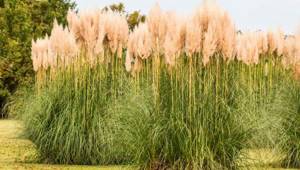
Under natural conditions, this species can be found in Korea, Russia, China, and Japan. This perennial is a grass with a loose bush. It has a rather short rhizome, and erect shoots can reach a height of about 300 centimeters. The hard, rough linear leaf plates are approximately 15 millimeters wide and have a rough rib running along the central vein. During flowering, single-flowered spikelets appear, which can reach 0.7 centimeters in length, and they are part of loose panicles. It has been cultivated since 1875. It is not highly frost-resistant; therefore, it simply needs dry shelter, and by winter you should not forget to sprinkle the area with a thick layer of mulch. This species is most popular among gardeners and approximately 100 of its varieties are known, differing in the shape and color of the inflorescences, as well as the outline and size of the bush itself. These include both frost-resistant varieties and those that prefer to grow in warm climates.
Varieties:
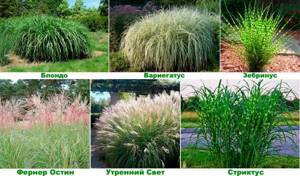
- Blondeau. It can reach 200 centimeters in height. Sufficiently frost-resistant, shelter is not required for the winter.
- Variegatus. The dense bush can reach only 150 centimeters in height. Its leaf blades have white longitudinal stripes.
- Miscanthus Zebrinus (in some cases called Miscanthus Zebrinus). The variegated bush on green leaf blades has yellow stripes that are arranged transversely.
- Furner Austin. The bush can reach 150 centimeters in height. On narrow green leaf plates along the central vein there is a white stripe, which in autumn becomes reddish-red. In August, fan-shaped panicles of a rich red color with white tips bloom; over time, they change their color to bronze-silver.
- Morning Light. The beautiful, not very tall bush has narrow leaf blades with a white edging. Flowering occurs quite late and not every year.
- Strictus. The bush reaches a height of 2.7 meters, the width of its richly colored variegated leaf blades is about 15 mm. The leaves alternately have green and rich white stripes; the loose panicles consist of single-flowered pale red spikelets.
Miscanthus sacchariflonis (Miscanthus sacchariflonis)
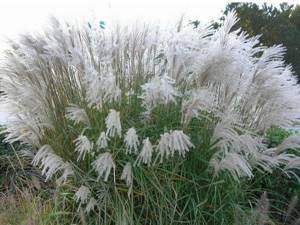
Under natural conditions, it can be found in Russia in damp areas from the south of the Primorsky Territory to the Amur Region, as well as in China, Korea and Japan. A bush with bare shoots can reach 200 centimeters in height. The drooping linear leaf plates are painted pale green, they are one and a half centimeters wide and about 0.6 m long. The panicles reach 0.25 m in length, and they are painted white or pink-silver. This species is a heat-loving species, so its growing season begins at the end of the spring period, but throughout the warm season its growth is characterized by high intensity. Flowering begins in July, and this grass can retain its decorative appearance until October. It is quite frost-resistant; shelter is not required for wintering, but it is better to mulch the area in case of little snow in the winter. The most popular form is Robustus; its bush is slightly larger than that of the main plant.
Miscanthus varieties
Morning Light
Now you are unlikely to be able to find the natural species of Chinese miscanthus on sale, but the rhizomes of numerous varieties obtained from it are sold in many shopping centers. And this is very good, because the varieties are much more diverse than the natural species.
Among them there are both compact plants, not exceeding 50 cm, and real giants, above 2 m.
The color of leaves and inflorescences has also become more diverse. But there is one drawback to varietal plants. Almost all of them bloom later than the original species. This means that not all varieties have time to bloom before frost in our climatic conditions. So, if the Chinese and sugar-flowered miscanthus bloom already in August, the earliest varieties will produce silver fans in late August - September, and the rest in October.
Of course, miscanthus is beautiful even before flowering, especially its variegated varieties. But if you definitely want to get maximum decorative value from a plant, it makes sense to grow only early varieties.
There are not many of them, they are all foreigners, so I give the name in the appropriate spelling.
Nippon is a bright green bush that grows no more than 150 cm.
Kleine Fontane is a bush 120-150 cm high with narrow variegated leaves.
Nishidake is a plant up to 170 cm high, forms dense bushes that do not fall apart.
And yet we cannot fail to mention the miscanthus varieties that bloom later. If the autumn is warm, you will be able to admire the fans of some of them. But, in any case, even without flowering, they will definitely decorate your garden.
Gracillivus - A unique variety, distinguished by the special grace of its narrow leaves. It reaches a height of 150 cm. It begins to bloom in late September - early October.
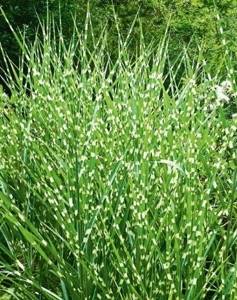
Strictus
Morning Light – Just as elegant and fully lives up to its name, which translated means “morning light”. A 150 cm tall bush with narrow leaves edged with a white stripe will really add morning light to the garden and will definitely improve your mood even on the rainiest and gloomiest day. The only pity is that it blooms late, and often does not have time to bloom at all.
Strictus – A showy variety with bright, variegated leaves. They are his calling card. Alternating transverse bright white and green stripes will definitely attract the attention of guests in your garden.
Zebrinus – Another variegated variety. Its distinctive feature is the yellowish transverse stripes on the leaves.
Punktchen – Also a variegated variety, with yellow stripes. It is distinguished by a loose bush and not so brightly colored stripes.
Variegatus – Compact (up to 150 cm in height), but forming a loose bush. Its highlight is the white longitudinal stripes on the leaves.
Conditions for growing miscanthus: place, soil and neighbors.
PLACE. Miscanthus grows well in full sun. When choosing a place for planting, leave a lot of space for the plant, because even one miscanthus bush will require a lot of space.
The best flowerbed neighbors for miscanthus are:
- Hibiscus
- Sunflower,
- Meadowsweet
- Dahlia / Dahlias
The SOIL for growing miscanthus should be well-drained, but not waterlogged. The plant tolerates acidic and heavy clay soils well.
Miscanthus indeed grows in a variety of soils over a wide pH range, but the optimal pH is between 5.5 and 7.5. The fallen leaves of the plant itself are an excellent fertilizer for it. Some farmers in Western countries specifically grow miscanthus to produce biomass, which is used as natural fertilizers and also as natural fuel. 20 tons of miscanthus is equivalent to 8 tons of coal.



